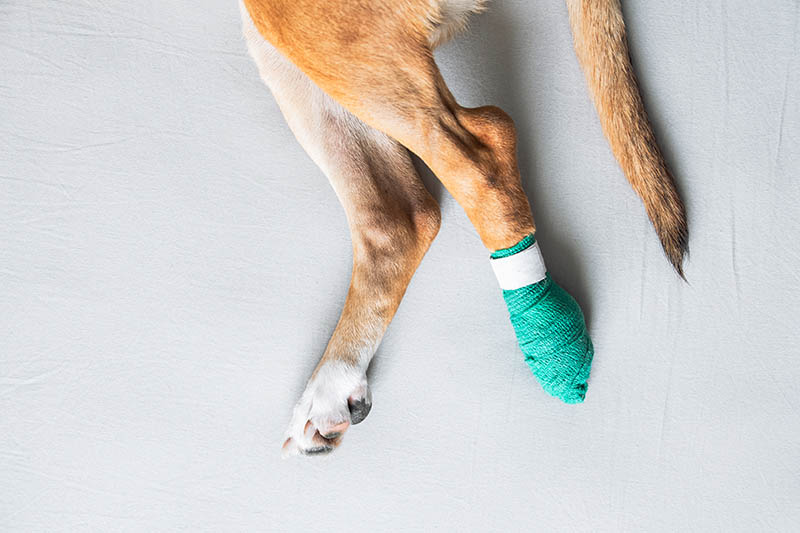Cut Your Dog’s Nail Too Short? Vet-Approved Tips & Next Steps
By Kit Copson
Updated on

Click to Skip Ahead
No matter how careful we are when trimming our dog’s nails, sometimes, accidents happen and you cut a nail too short, causing it to bleed. Your dog may yelp and move away from you because this is a painful experience, but it can also be very upsetting for you.
Don’t beat yourself up—gather a few simple household items to get to work on stopping the bleeding.
How to Stop the Bleeding
What You’ll Need:
- Styptic powder
- A clean paper towel or cloth
- Crushed ice (this may not be necessary)
Note: If you don’t have styptic powder, you can instead use a styptic pen, cornstarch, baking soda, baking powder, flour, a scent-free bar of soap, or a human styptic pencil (moistened) as an alternative.

Step-by-Step Guide
The most important thing is to stay calm. If your dog is already stressed, they’ll feed off your panic and get even more anxious (which may even cause them to bleed more due to increased blood pressure), so take a deep breath. Remember that your dog will be okay, and they will forgive you! Here are the steps for stopping the bleeding.
Note: Avoid wiping away blood while you’re going through these steps, as it could prevent the blood from clotting as it should.
1. Apply Pressure
Take a clean paper towel or cloth—whatever you have on hand—and press it on the end of the nail. Keep applying the same amount of pressure for around 2 minutes (more if necessary).
2. Apply Ice (Optional)

If after applying pressure for around 2 minutes you can still see blood dripping from the nail, fill a clean cloth with crushed ice. Place this ice pack on the end of the nail and apply pressure to the area just like in step one. Do this for at least 2 minutes. If you can’t see any blood dripping after step one, skip the ice and go straight to the next step.
3. Apply Styptic Powder
Styptic powder stops bleeding and helps numb pain, making it the perfect remedy for a nail that’s been cut too short. Apply a pea-sized amount of styptic powder (or one of the alternative remedies mentioned above if you don’t have any to hand) to the end of the nail and hold the pressure for 2 minutes. Alternatively, you can dip the nail directly in the styptic powder. Avoid putting pressure on the toe, as this could increase the bleeding.
What to Do When the Bleeding Stops?
Once the bleeding has stopped, try to have your dog not touch the ground for 30 minutes and avoid letting your dog lick the nail as this can lead to infection. If necessary a light dressing can be placed for a short period of time while the bleeding fully settles, and to stop your dog bothering at it. Make sure any bandages are not too tight, you should be able to slide two fingers under the bandage. Encourage your dog to stay on the couch or wherever they are, talk to them in a soft, reassuring tone, and give them plenty of fuss and a treat or two to cheer them up.
What If My Dog’s Nail Continues Bleeding?
If your dog’s nail continues to bleed even after applying crushed ice and styptic powder as detailed in the steps above, go through steps two and three again until the bleeding stops. If the nail continues to bleed after around 10 minutes despite your best efforts, wrap the paw in a light bandage and contact your vet for advice.

Nail Trimming Tips
Your dog may be reluctant to have their nails trimmed again for a while, so give them some time. Nevertheless, nail trimming is an important aspect of dog grooming for some dogs because allowing the nails to grow too long can result in joint problems, general pain and discomfort, and nails becoming detached from the nail bed (ouch!). Here are some tips for avoiding cutting nails too short in the future:
- Look for the “quick,” which is the pink part of the nail in dogs with white or clear nails. Avoid cutting into this zone.
- If your dog has black nails, the quick won’t be visible from the outside. Cut only 1mm off the nail at a time and look out for a dark oval within the nail between cuts, as this is a sign that you’re getting close to the quick.
- Use a photo of a dog with clear or white nails as an approximation of where the quick is if your dog has black nails, although be aware the position of the quick does vary between individuals.
- Use sharp dog nail clippers.
- Use a style of clippers you feel comfortable with. There are various kinds, including scissor-type clippers. These may feel more natural to you if you’re a beginner.
- Recruit a human assistant to reassure your dog.
- Keep an “emergency kit” (styptic powder and clean cloth) on hand throughout trimming sessions, just in case.
Final Thoughts
Nail trimming can seem intimidating for beginners, and it certainly takes practice, so stay calm and take your time. With time and practice, you should be able to trim your dog’s nails without any drama! If possible, touch your dog’s nails and paws regularly to get them used to the feeling, ideally from a young age.
If you’re not comfortable trimming your dog’s nails yourself, book an appointment with a professional groomer or at your veterinary practice.
Featured Image Credit: Imfoto,Shutterstock













